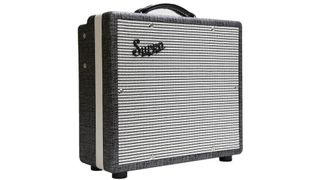SUMMER NAMM 2016: Supro is paying tribute to Keith Richards with the 1600 Supreme, an all-tube combo amp that replicates the Chicago-made 1x10 amp that the Rolling Stones guitarist has used down the years.
Two versions of the original 1959 Supreme amp were made: one bearing the Supro logo and another branded as Oahu. They were mechanically similar, but the Oahu version featured a pair of 6V6 power tubes in its Class-A output stage.
Designed as a "no-frills, grab-and-go amplifier", the 1600 Supreme can can be use for everything from jazz and country to hard rock, offering "clear, punchy tone, with unrivalled clarity, touch dynamics and low noise floor - even when pushed into glorious 6V6 power-tube overdrive."

The preamp, meanwhile, offers parallel gain stages that feed into a shared Tone knob. This is a dual-input preamp so can be shared between two instruments, or you can double up the gain on one instrument by plugging it into both inputs. You can also switch between channels to give you clean and dirty tones from one guitar.
Specs are below and you can see the 1600 Supreme being demoed in the video above. It'll be available in July priced at $1,249. Find out more on the Supro website.
Supro 1600 Supreme specs
- 1959 Vintage Supro Cosmetics and Circuitry
- 2 Channels with Parallel Link and shared tone control
- 25 Watts Cathode-Bias "Class-A" Power Amp
- Ample headroom for live performance with pedals
- 1×10" Custom Voiced Supro BD10 speaker
- EXT Speaker jack for matching extension cabinet
- 3x JJ 12AX7 preamp tubes
- 2x JJ 6V6 power tubes
- Gold Faceplate
- Black Rhino Hide Tolex
- 17 5/8" x 7 1/2" x 15 ½"
- 33.6 lbs / 15.3 kg
- Assembled in NY, USA

